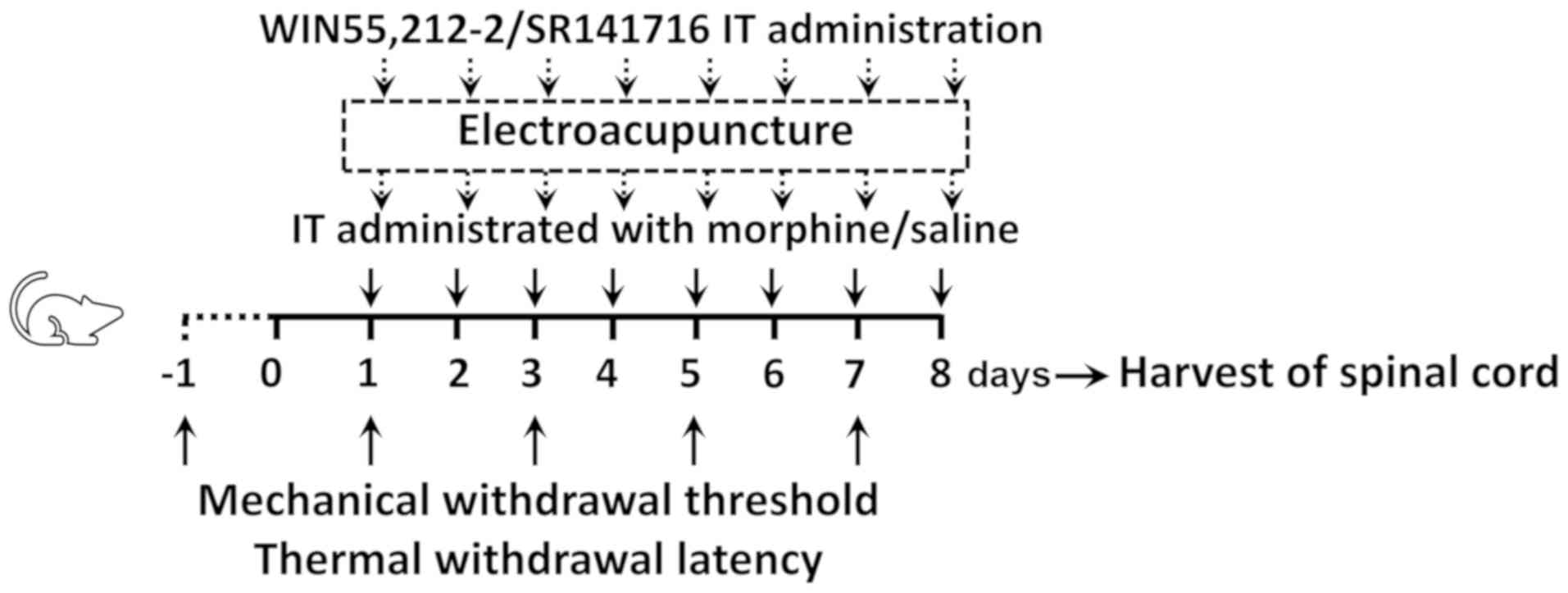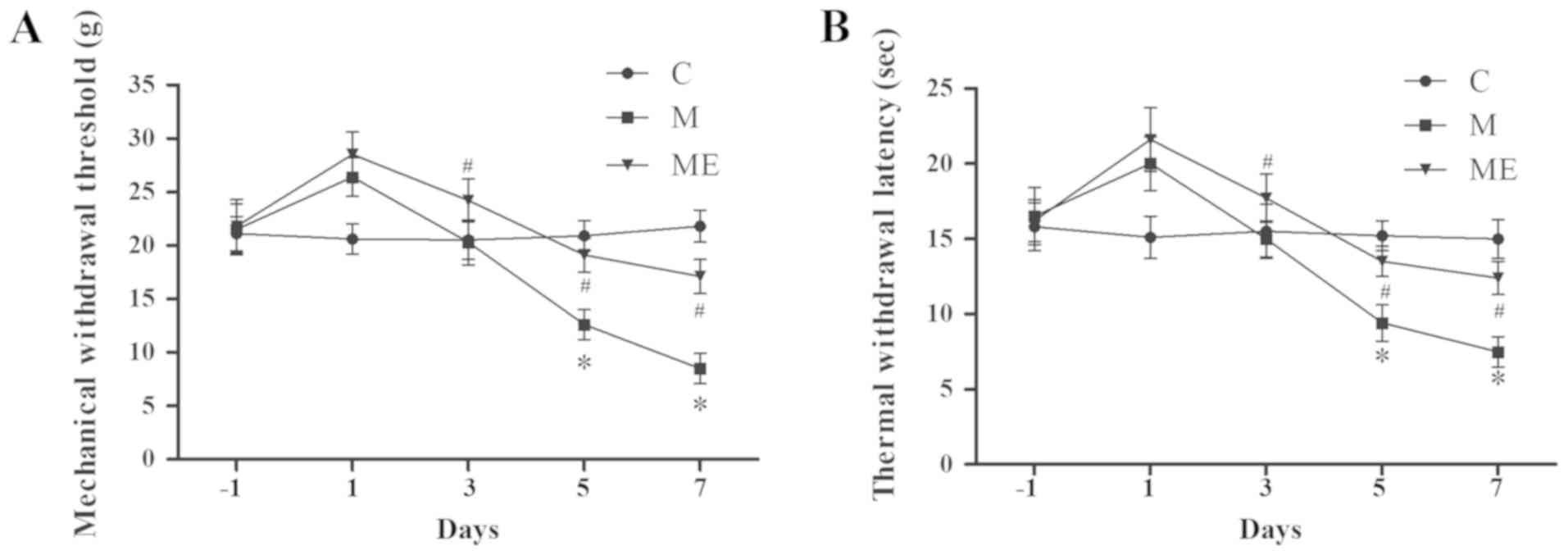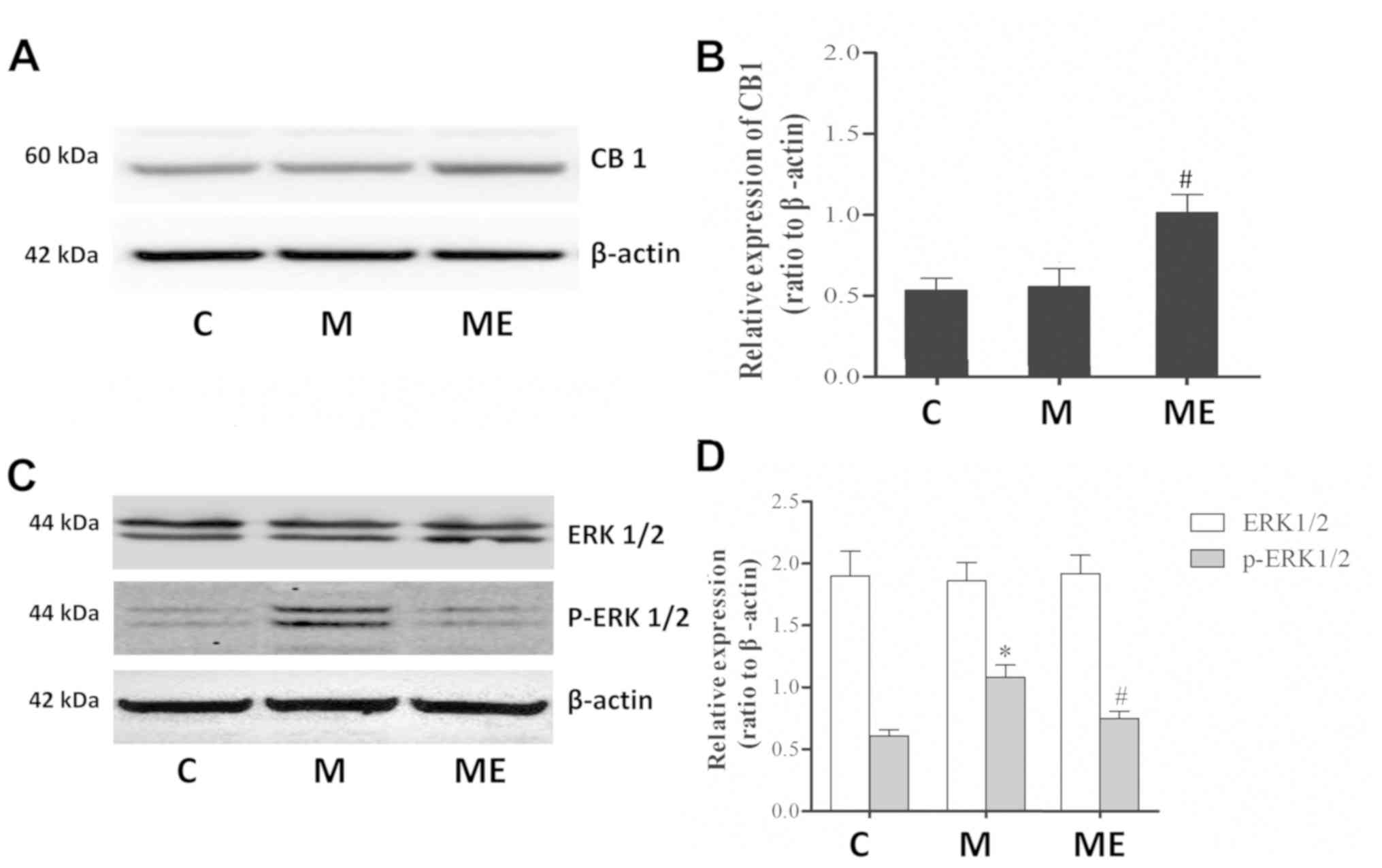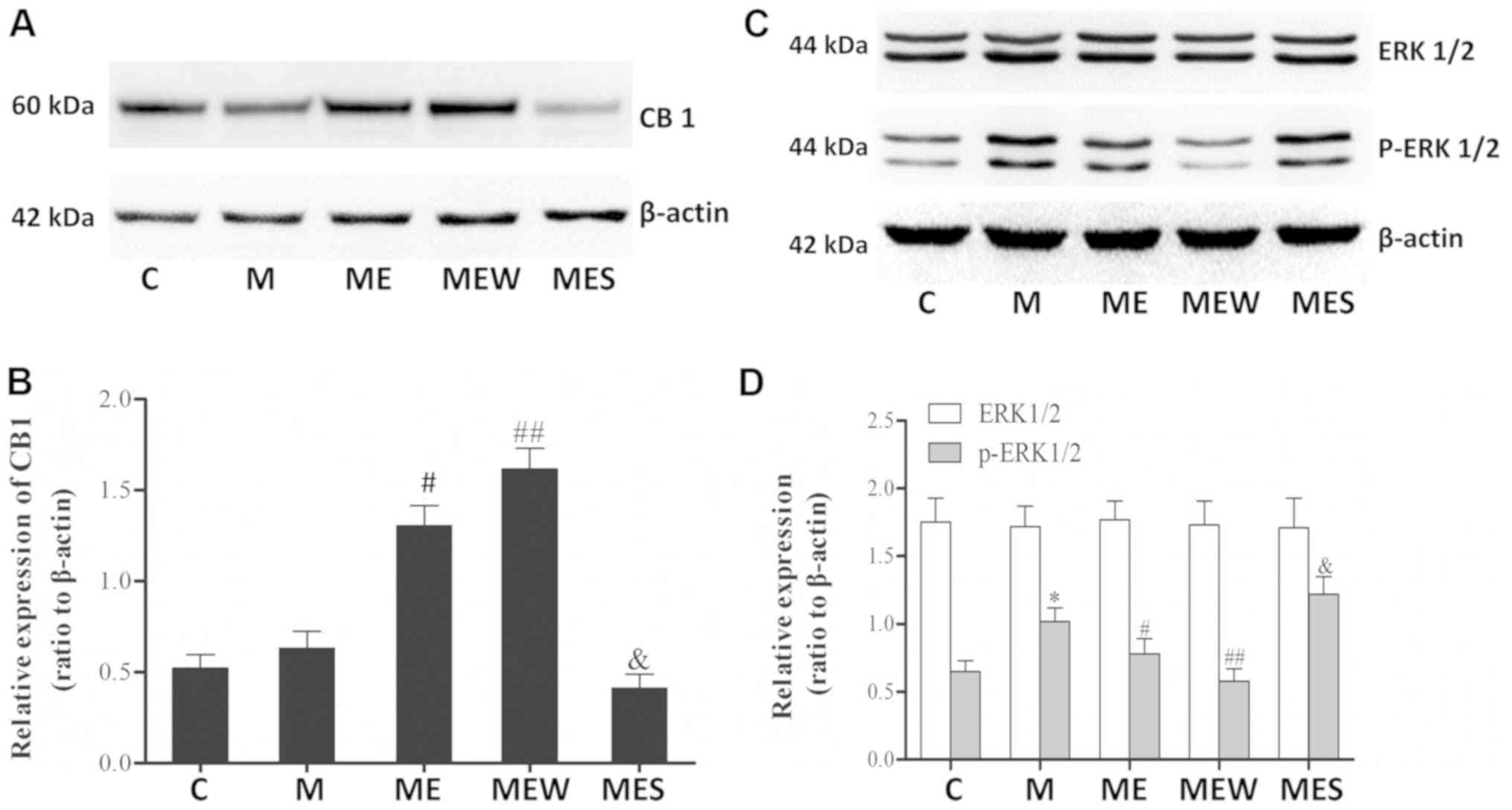|
1
|
Angst MS and Clark JD: Opioid-induced
hyperalgesia: A qualitative systematic review. Anesthesiology.
104:570–587. 2006. View Article : Google Scholar : PubMed/NCBI
|
|
2
|
Ossipov MH, Lai J, Vanderah TW and Porreca
F: Induction of pain facilitation by sustained opioid exposure:
Relationship to opioid antinociceptive tolerance. Life Sci.
73:783–800. 2003. View Article : Google Scholar : PubMed/NCBI
|
|
3
|
Ossipov MH, Lai J, King T, Vanderah TW and
Porreca F: Underlying mechanisms of pronociceptive consequences of
prolonged morphine exposure. Biopolymers. 80:319–324. 2005.
View Article : Google Scholar : PubMed/NCBI
|
|
4
|
Chen Y and Sommer C: The role of
mitogen-activated protein kinase (MAPK) in morphine tolerance and
dependence. Mol Neurobiol. 40:101–107. 2009. View Article : Google Scholar : PubMed/NCBI
|
|
5
|
Ma W, Zheng WH, Powell K, Jhamandas K and
Quirion R: Chronic morphine exposure increases the phosphorylation
of MAP kinases and the transcription factor CREB in dorsal root
ganglion neurons: An in vitro and in vivo study. Eur J Neurosci.
14:1091–1104. 2001. View Article : Google Scholar : PubMed/NCBI
|
|
6
|
Durham PL and Russo AF: Serotonergic
repression of mitogen-activated protein kinase control of the
calcitonin gene-related peptide enhancer. Mol Endocrinol.
12:1002–1009. 1998. View Article : Google Scholar : PubMed/NCBI
|
|
7
|
Wang Z, Ma W, Chabot JG and Quirion R:
Cell-type specific activation of p38 and ERK mediates calcitonin
gene-related peptide involvement in tolerance to morphine-induced
analgesia. FASEB J. 23:2576–2586. 2009. View Article : Google Scholar : PubMed/NCBI
|
|
8
|
Zogopoulos P, Vasileiou I, Patsouris E and
Theocharis SE: The role of endocannabinoids in pain modulation.
Fundam Clin Pharmacol. 27:64–80. 2013. View Article : Google Scholar : PubMed/NCBI
|
|
9
|
Matsuda LA, Lolait SJ, Brownstein MJ,
Young AC and Bonner TI: Structure of a cannabinoid receptor and
functional expression of the cloned cDNA. Nature. 346:561–564.
1990. View
Article : Google Scholar : PubMed/NCBI
|
|
10
|
Munro S, Thomas KL and Abu-Shaar M:
Molecular characterization of a peripheral receptor for
cannabinoids. Nature. 365:61–65. 1993. View
Article : Google Scholar : PubMed/NCBI
|
|
11
|
Matsuda LA, Bonner TI and Lolait SJ:
Localization of cannabinoid receptor mRNA in rat brain. J Comp
Neurol. 327:535–550. 1993. View Article : Google Scholar : PubMed/NCBI
|
|
12
|
Zimmer A, Zimmer AM, Hohmann AG, Herkenham
M and Bonner TI: Increased mortality, hypoactivity, and hypoalgesia
in cannabinoid CB1 receptor knockout mice. Proc Natl Acad Sci USA.
96:5780–5785. 1999. View Article : Google Scholar : PubMed/NCBI
|
|
13
|
Lim G, Sung B, Ji RR and Mao J:
Upregulation of spinal cannabinoid-1-receptors following nerve
injury enhances the effects of Win 55,212-2 on neuropathic pain
behaviors in rats. Pain. 105:275–283. 2003. View Article : Google Scholar : PubMed/NCBI
|
|
14
|
da Fonseca Pacheco D, Klein A, de Castro
Perez A, da Fonseca Pacheco CM, de Francischi JN and Duarte ID: The
mu-opioid receptor agonist morphine, but not agonists at delta- or
kappa-opioid receptors, induces peripheral antinociception mediated
by cannabinoid receptors. Br J Pharmacol. 154:1143–1149. 2008.
View Article : Google Scholar : PubMed/NCBI
|
|
15
|
Pacher P and Mechoulam R: Is lipid
signaling through cannabinoid 2 receptors part of a protective
system. Prog Lipid Res. 50:193–211. 2011. View Article : Google Scholar : PubMed/NCBI
|
|
16
|
Tumati S, Largent-Milnes TM, Keresztes A,
Ren J, Roeske WR, Vanderah TW and Varga EV: Repeated morphine
treatment-mediated hyperalgesia, allodynia and spinal glial
activation are blocked by co-administration of a selective
cannabinoid receptor type-2 agonist. J Neuroimmunol. 244:23–31.
2012. View Article : Google Scholar : PubMed/NCBI
|
|
17
|
Zhang Z, Wang C, Gu G, Li H, Zhao H, Wang
K, Han F and Wang G: The effects of electroacupuncture at the ST36
(Zusanli) acupoint on cancer pain and transient receptor potential
vanilloid subfamily 1 expression in Walker 256 tumor-bearing rats.
Anesth Analg. 114:879–885. 2012. View Article : Google Scholar : PubMed/NCBI
|
|
18
|
Yu J, Zhao C and Luo X: The effects of
electroacupuncture on the extracellular signal-regulated kinase
1/2/P2X3 signal pathway in the spinal cord of rats with chronic
constriction injury. Anesth Analg. 116:239–246. 2013. View Article : Google Scholar : PubMed/NCBI
|
|
19
|
Yin CS, Jeong HS, Park HJ, Baik Y, Yoon
MH, Choi CB and Koh HG: A proposed transpositional acupoint system
in a mouse and rat model. Res Vet Sci. 84:159–165. 2008. View Article : Google Scholar : PubMed/NCBI
|
|
20
|
Gondim DV, Araújo JC, Cavalcante AL, Havt
A, Quetz Jda S, Brito GA, Ribeiro Rde A and Lima Vale M: CB1 and
CB2 contribute to antinociceptive and anti-inflammatory effects of
electroacupuncture on experimental arthritis of the rat
temporomandibular joint. Can J Physiol Pharmacol. 90:1479–1489.
2012. View Article : Google Scholar : PubMed/NCBI
|
|
21
|
Du J, Wang Q, Hu B, Peng Z, Zhao Y, Ma L,
Xiong L, Lu Y, Zhu X and Chen S: Involvement of ERK 1/2 activation
in electroacupuncture pretreatment via cannabinoid CB1 receptor in
rats. Brain Res. 1360:1–7. 2010. View Article : Google Scholar : PubMed/NCBI
|
|
22
|
Jang JY, Kim HN, Koo ST, Shin HK, Choe ES
and Choi BT: Synergistic antinociceptive effects of
N-methyl-D-aspartate receptor antagonist and electroacupuncture in
the complete Freund's adjuvant-induced pain model. Int J Mol Med.
28:669–675. 2011.PubMed/NCBI
|
|
23
|
Katsuyama S, Mizoguchi H, Komatsu T,
Nagaoka K, Sakurada S and Sakurada T: The cannabinoid 1 receptor
antagonist AM251 produces nocifensive behavior via activation of
ERK signaling pathway. Neuropharmacology. 59:534–541. 2010.
View Article : Google Scholar : PubMed/NCBI
|
|
24
|
Yaksh TL and Rudy TA: Chronic
catheterization of the spinal subarachnoid space. Physiol Behav.
17:1031–1036. 1976. View Article : Google Scholar : PubMed/NCBI
|
|
25
|
Cui JH, Kim WM, Lee HG, Kim YO, Kim CM and
Yoon MH: Antinociceptive effect of intrathecal cannabinoid receptor
agonist WIN 55,212-2 in a rat bone tumor pain model. Neurosci Lett.
493:67–71. 2011. View Article : Google Scholar : PubMed/NCBI
|
|
26
|
Johanek LM, Heitmiller DR, Turner M, Nader
N, Hodges J and Simone DA: Cannabinoids attenuate capsaicin-evoked
hyperalgesia through spinal and peripheral mechanisms. Pain.
93:303–315. 2001. View Article : Google Scholar : PubMed/NCBI
|
|
27
|
Shou Y, Yang Y, Xu MS, Zhao YQ, Ge LB and
Zhang BM: Electroacupuncture inhibition of hyperalgesia in rats
with adjuvant arthritis: Involvement of cannabinoid receptor 1 and
dopamine receptor subtypes in striatum. Evid Based Complement
Alternat Med. 2013:3934602013. View Article : Google Scholar : PubMed/NCBI
|
|
28
|
Park JY, Park JJ, Jeon S, Doo AR, Kim SN,
Lee H, Chae Y, Maixner W, Lee H and Park HJ: From peripheral to
central: The role of ERK signaling pathway in acupuncture
analgesia. J Pain. 15:535–549. 2014. View Article : Google Scholar : PubMed/NCBI
|
|
29
|
Ji RR, Baba H, Brenner GJ and Woolf CJ:
Nociceptive-specific activation of ERK in spinal neurons
contributes to pain hypersensitivity. Nat Neurosci. 2:1114–1119.
1999. View Article : Google Scholar : PubMed/NCBI
|
|
30
|
Obata K and Noguchi K: MAPK activation in
nociceptive neurons and pain hypersensitivity. Life Sci.
74:2643–2653. 2004. View Article : Google Scholar : PubMed/NCBI
|
|
31
|
Cao JL, Liu HL, Wang JK and Zeng YM: Cross
talk between nitric oxide and ERK1/2 signaling pathway in the
spinal cord mediates naloxone-precipitated withdrawal in
morphine-dependent rats. Neuropharmacology. 51:315–326. 2006.
View Article : Google Scholar : PubMed/NCBI
|
|
32
|
Chen Y, Geis C and Sommer C: Activation of
TRPV1 contributes to morphine tolerance: Involvement of the
mitogen-activated protein kinase signaling pathway. J Neurosci.
28:5836–5845. 2008. View Article : Google Scholar : PubMed/NCBI
|
|
33
|
Cao JL, He JH, Ding HL and Zeng YM:
Activation of the spinal ERK signaling pathway contributes
naloxone-precipitated withdrawal in morphine-dependent rats. Pain.
118:336–349. 2005. View Article : Google Scholar : PubMed/NCBI
|
|
34
|
Rani Sagar D, Burston JJ, Woodhams SG and
Chapman V: Dynamic changes to the endocannabinoid system in models
of chronic pain. Philos Trans R Soc Lond B Biol Sci. 367:3300–3311.
2012. View Article : Google Scholar : PubMed/NCBI
|
|
35
|
Svízenská I, Dubový P and Sulcová A:
Cannabinoid receptors 1 and 2 (CB1 and CB2), their distribution,
ligands and functional involvement in nervous system structures-a
short review. Pharmacol Biochem Behav. 90:501–511. 2008. View Article : Google Scholar : PubMed/NCBI
|
|
36
|
Wei H, Yao X, Yang L, Wang S, Guo F, Zhou
H, Marsicano G, Wang Q and Xiong L: Glycogen synthase kinase-3β is
involved in electroacupuncture pretreatment via the cannabinoid CB1
receptor in ischemic stroke. Mol Neurobiol. 49:326–336. 2014.
View Article : Google Scholar : PubMed/NCBI
|
|
37
|
Bridges D, Ahmad K and Rice AS: The
synthetic cannabinoid WIN55,212-2 attenuates hyperalgesia and
allodynia in a rat model of neuropathic pain. Br J Pharmacol.
133:586–594. 2001. View Article : Google Scholar : PubMed/NCBI
|
|
38
|
Ribeiro R, Wen J, Li S and Zhang Y:
Involvement of ERK1/2, cPLA2 and NF-κB in microglia suppression by
cannabinoid receptor agonists and antagonists. Prostaglandins Other
Lipid Mediat. 100-101:1–14. 2013. View Article : Google Scholar : PubMed/NCBI
|



















